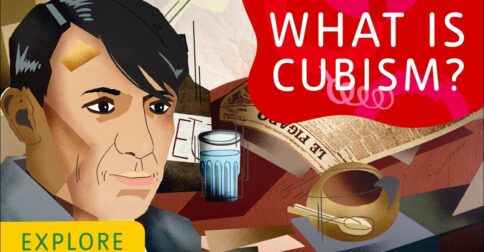[Most Recent Entries] [Calendar View]
Tuesday, February 8th, 2022
| Time | Event |
| 9:00a | Pink Floyd’s Debut on American TV, Restored in Color (1967) 
Several years ago, Josh Jones took you inside Pink Floyd’s first appearance on American television. In 1967, after releasing their first album Piper at the Gates of Dawn, the band came to the States and made their unlikely TV debut on Dick Clark’s American Bandstand, performing “Apples and Oranges.” That’s the “third single and the final song Barrett wrote for the band before he suffered a psychotic break onstage and was replaced by David Gilmour.” Our original post featured grainy black and white footage of the appearance. Above, you can watch a restored, colorized version that took nearly a year to create. According to the YouTube channel “Artist on the Border,” each “frame of the 3350 required frames had to be uploaded individually, downloaded again and individually named.” Enjoy the fruits of their labor above. If you would like to sign up for Open Culture’s free email newsletter, please find it here. If you would like to support the mission of Open Culture, consider making a donation to our site. It’s hard to rely 100% on ads, and your contributions will help us continue providing the best free cultural and educational materials to learners everywhere. You can contribute through PayPal, Patreon, Venmo (@openculture) and Crypto. Thanks! Related Content Pink Floyd Performs on US Television for the First Time: American Bandstand, 1967 Talking Heads’ First TV Appearance Was on American Bandstand, and It Was a Little Awkward (1979) |
| 12:00p | The Fiendishly Complicated Board Game That Takes 1,500 Hours to Play: Discover The Campaign for North Africa 
Monopoly is notoriously time-consuming. On the childhood Christmas I received my first copy of that Parker Brothers classic, my dad and I started a game that ended up spreading over two or three days. That may have had to do with my appreciation for Monopoly’s aesthetic far exceeding my grasp of its aim, and I’ve since realized that it can be played in about an hour. That’s still a good deal longer than, say, a game of checkers, but it falls somewhat short of the league occupied by The Campaign for North Africa — which is, in fact, a league of its own. Since its publication in 1979, it’s been known as the longest board game in existence, requiring 1,500 hours (or 62 days) to complete. We are, of course, talking about a war game, and that genre has its own standards of complexity — standards The Campaign for North Africa leaves in the dust. “The game itself covers the famous WWII operations in Libya and Egypt between 1940 and 1943,” writes Kotaku’s Luke Winkle. “You’ll need to recruit 10 total players, (five Allied, five Axis,) who will each lord over a specialized division. The Front-line and Air Commanders will issue orders to the troops in battle, the Rear and Logistics Commanders will ferry supplies to the combat areas, and lastly, a Commander-in-Chief will be responsible for all macro strategic decisions over the course of the conflict. If you and your group meets for three hours at a time, twice a month, you’d wrap up the campaign in about 20 years.” You can get an idea of what you’d be dealing with over those two decades in the video below from Youtuber Phasing Player, an overview that itself takes about an hour and a half. “Honestly, if I’m being straight-up here, this game does sound, broadly speaking, like a fun time,” he says, half an hour deep into the explanation. “Imagine setting up a giant map of Africa,” getting your friends together, “Sarah’s in charge of the air force and Jim is in charge of logistics. You have all these people in charge of different things, and you’re communicating strategies, and the commander-in-chief is formulating plans and doing all this stuff. That sounds like a real hoot, right?” Alas, “the big asterisk comes in when that good time has to last literally a thousand hours,” involving what another player quoted by Winkle calls “doing tedious calculations all the time.” Those calculations necessitate paying close attention, on every single turn, to not just quantities like fuel reserves but the historically accurate size of the barrels containing those reserves. Note also that, as Winkle adds, “the Italian troops in World War II were outfitted with noodle rations, and in the name of historical dogma, the player responsible for the Italians is required to distribute an extra water ration to their forces, so that their pasta may be boiled.” The Campaign for North Africa‘s designer, the late Richard Berg, claimed that the so-called “pasta rule” was a joke, and that the game’s fiendish overall complexity was in keeping with the style of the times, a “golden age” of war gaming with high sales and ever-escalating ambitions. As with so many other seemingly inexplicable artifacts of cultural history, one falls back on a familiar explanation: hey, it was the 70s. via Kotaku Related content: Learn to Play Senet, the 5,000-Year Old Ancient Egyptian Game Beloved by Queens & Pharaohs The Fear and Loathing in Las Vegas Board Game, Inspired by Hunter S. Thompson’s Rollicking Novel Monopoly: How the Original Game Was Made to Condemn Monopolies & the Abuses of Capitalism Download & Play the Shining Board Game Board Game Ideology — Pretty Much Pop: A Culture Podcast #108 Based in Seoul, Colin Marshall writes and broadcasts on cities, language, and culture. His projects include the Substack newsletter Books on Cities, the book The Stateless City: a Walk through 21st-Century Los Angeles and the video series The City in Cinema. Follow him on Twitter at @colinmarshall or on Facebook. |
| 4:00p | Tate Kids Presents Introductions to Art Movements: Cubism, Impressionism, Surrealism & More 
Tate Kids has a solid grasp on the sort of hands on art-related content that appeals to children – Make a mud painting! Make a spaghetti sculpture! Photo filter challenge! Children of all ages, grown ups who skipped out on art history included, will benefit from their breakneck overviews of entire art movements. Take cubism. The Tate Kids’ animation, above, provides a solid if speedy overview, zipping through eight canvases, six artists, and explanations of the movement’s two phases – analytical and synthetic. (Three phases if you count Orphism, the abstract, cubist influenced painting style married artists Robert and Sonia Delaunay hatched around 1912.) Given the intended audience, the fond friendship between the fathers of cubism, Georges Braque and Pablo Picasso looms large, with nary a peep about Picasso’s narcissism and misogyny. And it must be said that the narrator’s tone grates a bit – a bit too loud, a bit too wowed. The Impressionists come off as the real cool kids, with a different narrator, and nifty collage animations that find Camille Pissarro throwing horns and a Mohawked Alfred Sisley as they reject the Salon‘s insistence on “myths, battles and paintings of important people.” Their defiant spirit is supported by criticism that most definitely has not stood the test of time: Pure evil! Wallpaper! Like a monkey has got hold of a box of paints! Kid presenters seize the controls for an introduction to the mid-century Japanese avant-garde movement, Gutai. Their conclusion? Smashing things up is fun! As are manifestos: Let’s bid farewell to the hoaxes piled up on the altars and in the palaces, the drawing rooms and the antique shops…Lock up these corpses in the graveyard! Yay! Those who are poorly equipped to stomach the narrators’ whizbang enthusiasm should take a restorative minutes to visit the museum oranges in hand, with 12-year-old Jaeda and 9-year-old Fatimatu. Their calm willingness to engage with conceptual art is a tonic: When I started art, I though art was just about making it perfect, but you don’t have to care what other people say. That could still mean an art to you. Watch a Tate Kids Art Movements playlist on YouTube. Supplement what you’ve learned with a host of Tate Kids activities, coloring pages, games, quizzes, artist bios and a gallery of crowdsourced kid art. Related Content The Tate Digitizes 70,000 Works of Art: Photos, Sketchbooks, Letters & More A 110-Year-Old Book Illustrated with Photos of Kittens & Cats Taught Kids How to Read – Ayun Halliday is the Chief Primatologist of the East Village Inky zine and author, most recently, of Creative, Not Famous: The Small Potato Manifesto. Follow her @AyunHalliday. |
| << Previous Day |
2022/02/08 [Calendar] |
Next Day >> |





